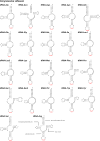Characterization of the complete mitochondrial genomes of the zoonotic parasites Bolbosoma nipponicum and Corynosoma villosum (Acanthocephala: Polymorphida) and the molecular phylogeny of the order Polymorphida
- PMID: 37955106
- PMCID: PMC10941042
- DOI: 10.1017/S0031182023001099
Characterization of the complete mitochondrial genomes of the zoonotic parasites Bolbosoma nipponicum and Corynosoma villosum (Acanthocephala: Polymorphida) and the molecular phylogeny of the order Polymorphida
Abstract
Acanthocephalans of the order Polymorphida mainly parasitic in birds and mammals, are of veterinary, medical and economic importance. However, the evolutionary relationships of its 3 families (Centrorhynchidae, Polymorphidae and Plagiorhynchidae) remain under debate. Additionally, some species of Polymorphida (i.e. Bolbosoma spp. and Corynosoma spp.) are recognized as zoonotic parasites, associated with human acanthocephaliasis, but the mitochondrial genomes for representatives of Bolbosoma and Corynosoma have not been reported so far. In the present study, the complete mitochondrial genomes B. nipponicum and C. villosum (Acanthocephala: Polymorphidae) are reported for the first time, which are 14 296 and 14 241 bp in length, respectively, and both contain 36 genes [including 12 PCGs, 22 tRNA genes and 2 rRNA genes] and 2 non-coding regions (NCR1 and NCR2). The gene arrangement of some tRNAs in the mitogenomes of B. nipponicum and C. villosum differs from that found in all other acanthocephalans, except Polymorphus minutus. Phylogenetic results based on concatenated amino acid (AA) sequences of the 12 protein-coding genes (PCGs) strongly supported that the family Polymorphidae is a sister to the Centrorhynchidae rather than the Plagiorhynchidae, and also confirmed the sister relationship of the genera Bolbosoma and Corynosoma in the Polymorphidae based on the mitogenomic data for the first time. Our present findings further clarified the phylogenetic relationships of the 3 families Plagiorhynchidae, Centrorhynchidae and Polymorphidae, enriched the mitogenome data of the phylum Acanthocephala (especially the order Polymorphida), and provided the resource of genetic data for diagnosing these 2 pathogenic parasites of human acanthocephaliasis.
Keywords: Acanthocephala; Bolbosoma; Corynosoma; Polymorphidae; mitochondrial genome; molecular phylogeny; zoonotic parasite.
Conflict of interest statement
None.
Figures







References
-
- Amin OM (2013) Classification of the Acanthocephala. Folia Parasitologica 60, 273–305. - PubMed
-
- Arizono N, Kuramochi T and Kagei N (2012) Molecular and histological identification of the acanthocephalan Bolbosoma cf. capitatum from the human small intestine. Parasitology International 61, 715–718. - PubMed
-
- Aznar FJ, de León GP and Raga JA (2006) Status of Corynosoma (Acanthocephala: Polymorphidae) based on anatomical, ecological, and phylogenetic evidence, with the erection of Pseudocorynosoma n. gen. The Journal of Parasitology 92, 548–564. - PubMed
-
- Beaver PC, Otsuji T, Otsuji A, Yoshimura H, Uchikawa R and Sato A (1983) Acanthocephalan, probably Bolbosoma, from the peritoneal cavity of man in Japan. The American Journal of Tropical Medicine and Hygiene 32, 1016–1018. - PubMed
MeSH terms
Grants and funding
LinkOut - more resources
Full Text Sources
Miscellaneous

